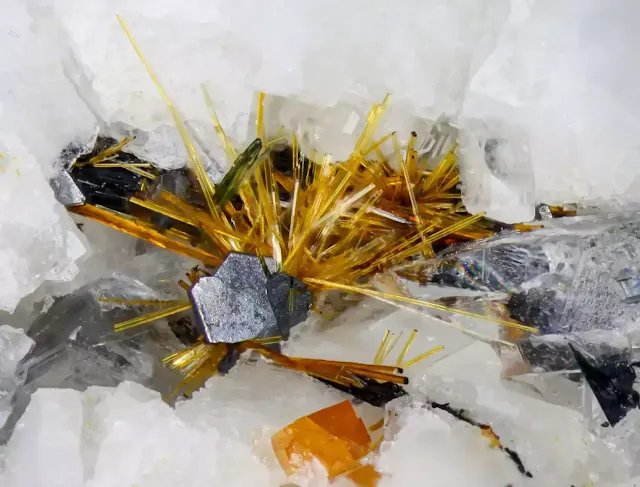Astrophyllite: Properties, Mineral Information
Astrophyllite minerals form in igneous rock deposited in cavities and fissures within the Earth’s crust. Igneous rock is formed during the cooling and solidification of liquid magma which can occur in one of two ways; the liquid magma can cool and solidify slowly underground or can be cooled and solidified quickly in the atmosphere or on the surface of the Earth after a volcanic explosion. When igneous rock is released into the atmosphere from a volcanic eruption it is known as pumice. Astrophyllite can be found in large masses of igneous rock and within pegmatite.
 |
Astrophyllite: Mineral Information. From Água de Pau volcano, San Miguel Island, Azores District, Portugal. Photo: Serge Lavard
|
Properties of Astrophyllite
Composition: Astrophyllite is primarily composed of potassium, sodium, iron, manganese, and titanium silicate, with the chemical formula K₂NaFe²+₅.₂₅Mn²+Mg₀.₇₅Ti₂Si₈O₂₇(OH)₃.₅F₀.₅
Color: It typically exhibits a striking bronze to golden-yellow color, often with black or copper-colored striations.
Transparency: Astrophyllite is usually translucent to opaque.
Luster: Its luster can range from Adamantine to pearly. Adamantine luster refers to a brilliant, diamond-like luster while pearly luster has an iridescent sheen, like a pearl.
Crystal System: Astrophyllite crystallizes in the monoclinic system.
Streak: The streak of astrophylite is usually brownish-yellow.
Hardness: It has a hardness ranging from 3.5 on the Mohs scale.
Cleavage: Astrophyllite displays perfect cleavage in two directions.
Fracture: Its fracture is uneven.
Habits and Forms: Astrophyllite commonly occurs in prismatic crystals, but it can also be found in fibrous, radiating, and granular aggregates. It often forms as tabular or bladed crystals.
Density: The density of astrophylite ranges from about 3.2 to 3.4 g/cm³.
Specific Gravity: Its specific gravity typically falls between 3.0 and 3.4.
Solubility: Astrophyllite is insoluble in common acids and has negligible solubility in water.
Magnetism: It is typically non-magnetic.
Fluorescence: Strong, blue, purple, pink or orange under ultraviolet light [1]. Fluorescence is the property of a substance to emit light when exposed to ultraviolet radiation.
Pleochroism: Astrophyllite may display pleochroism, showing different colors when viewed from different angles.
Refractive Index: The refractive index of astrophylite ranges from approximately 1.615 to 1.725.
Inclusions: Astrophyllite often contains inclusions of other minerals, such as feldspar, quartz, or mica, which contribute to its unique appearance.
Associations Minerals: Astrophyllite is commonly associated with minerals such as quartz, feldspar, mica, and various other silicates in metamorphic rocks, particularly in nepheline syenite pegmatites and skarns.
Other Characteristics: color is often patchy or heterogenous in distribution.
Notable Occurrences include Kola Penensula, Khibina, Russia; Colorado, USA and Mt St. Hilaire, Quebec, Canada.
Best Field Indicators brittleness, cleavage, color, luster and localities.
 |
| Astrophyllite. Photo: Henk Smeets/Tomeik Minerals. |
Astrophyllite Occurrence and Distribution
Astrophyllite is found in a variety of geological environments, but its distribution is not widespread. This contributes to its value among mineral collectors. Here's a breakdown of its occurrence and distribution:
Commonly associated with alkaline pegmatites, nepheline syenites, and other igneous rocks. These are intrusive igneous rocks that form deep underground when magma rich in sodium and potassium cools slowly. Pegmatites are coarse-grained igneous rocks that form from the last bits of magma to crystallize. They can contain large crystals of unusual minerals, like astrophyllite.
Locations: While deposits are scattered globally, some prominent locations include:
Russia: One of the significant sources of astrophylite is the Kola Peninsula in Russia, where it occurs in alkaline pegmatites and syenites.
Greenland: Astrophyllite has been found in alkaline pegmatites in Greenland.
Norway: In Norway, astrophylite is associated with nepheline syenite complexes, particularly in the Langesundsfjord area.
Canada: Some occurrences of astrophylite are reported in Canada, including in the province of Quebec.
United States: Astrophyllite has been found in several locations in the United States, including Colorado, Maine, and New York. However, the occurrences are relatively sparse compared to some other minerals.
 |
| Astrophyllite. Photo: Henk Smeets/Tomeik Minerals. |
Astrophyllite Uses
Astrophyllite, while not widely used for industrial purposes, is appreciated for its aesthetic qualities and has some niche applications. Here are a few notable uses of astrophyllite:
Ornamental and Collectible Purposes:
Astrophyllite is highly valued for its distinctive and beautiful radiating or star-like crystal formations. Many people collect astrophyllite specimens for display in mineral collections or as ornamental pieces.
Metaphysical and Spiritual Practices:
In certain metaphysical and spiritual circles, astrophyllite is believed to possess unique energy properties. Some individuals use it for meditation, healing, or as a tool for enhancing psychic abilities. It is thought to bring harmony, balance, and insight.
Jewelry:
Although not as common as other gemstones, astrophyllite has been used in jewelry as cabochons or polished stones. The star-like patterns make it an attractive choice for unique and artistic jewelry pieces.
Lapidary Art:
Astrophyllite, with its intricate crystal patterns, can be used in lapidary art. Lapidarists may cut and shape astrophyllite into various forms, showcasing its natural beauty.



%20(1).webp)




